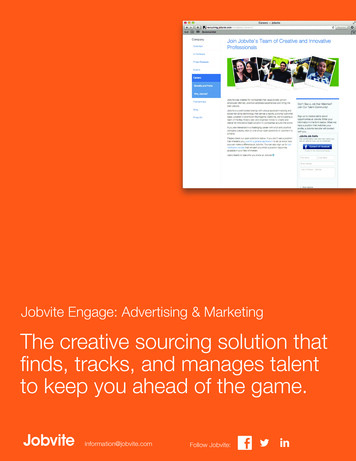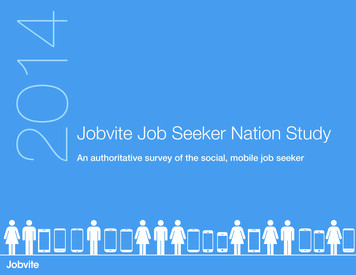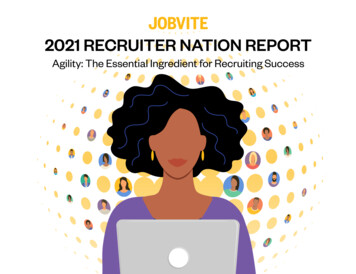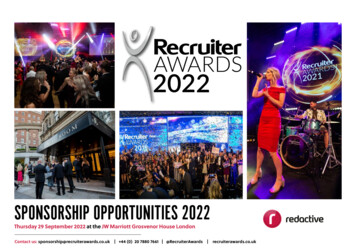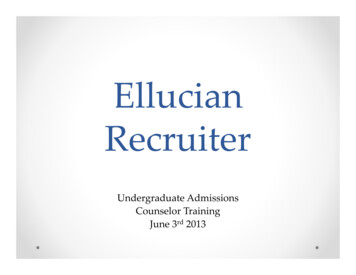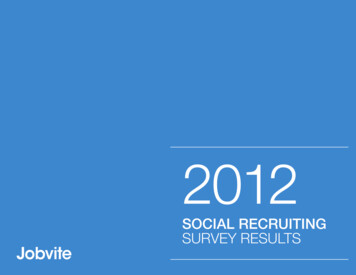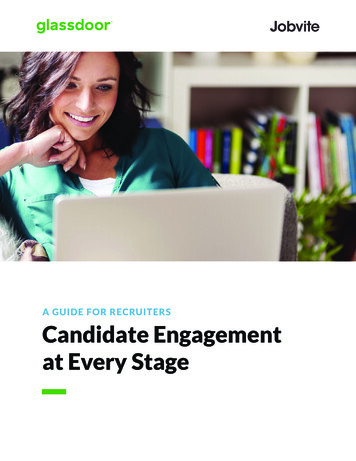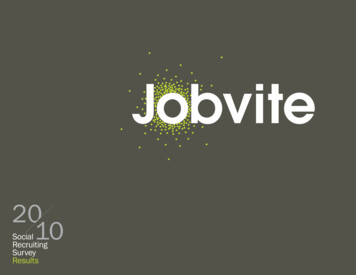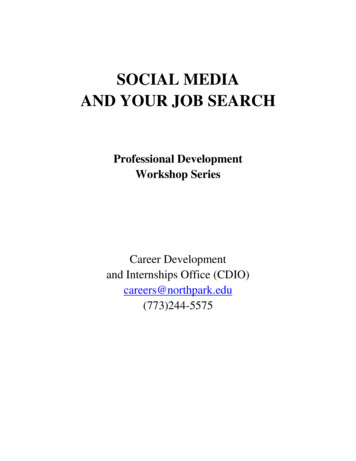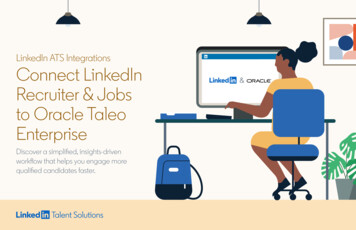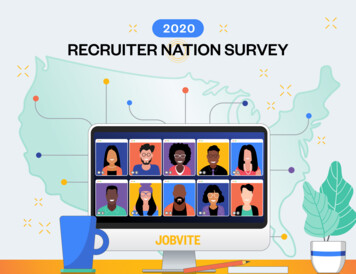
Transcription
RECRUITER NATION SURVEY
INTRODUCTIONYear after year, Jobvite surveys hundreds of recruiters and HRprofessionals for its annual Recruiter Nation Survey report todetermine where the industry’s priorities lie and what currenthiring trends are. As uncovered in this year’s report, recruitersbelieve that many of the shifts brought forth in 2020 – from newand virtual interviewing and onboarding methods to investmentsand priorities – will be here to stay.This year’s Recruiter Nation Survey report aims to help recruitersand talent acquisition leaders across the U.S. understand:Recruiting priorities and investmentsStress levels of recruiters todayAs Americans continue to face significant societal challengesand change in 2020, the impact is being felt by talent acquisitionprofessionals from organizations of all sizes and across allindustries. Unsurprisingly, the majority of recruiters today reportan increased stress level at work since the onset of the COVID-19pandemic along with diminished headcount and hiring.Challenges in hiring quality talentImportance of D&I initiativesSalary negotiation in today’s hiring climateEffective interview and communication tactics andtechnologyWith this year prompting many Americans to reflect on whatis important to them and what their values are, it is fitting thatthose beliefs and priorities are being brought into the job search.Organizations’ diversity and inclusion initiatives, flexibility,accommodations for working parents, and mental health benefitofferings are gaining in importance among candidates. Meanwhile,finding candidates who are cultural fits is viewed as a lessimportant factor for recruiters in today’s increasingly remote workenvironment.Importance of COVID-19 safety measuresValuable metrics for tracking recruiting successTop-rated sources for hiringTrends in social media for recruitingDespite a tumultuous year, job seekers appear to remain confident,with recruiters reporting an increase in candidates negotiating forhigher salaries.Candidate evaluation factors and measurementEffective benefit and perk offeringsHow recruiters are using AI and automation2020 Recruiter Nation Survey2jobvite.com
KEY TAKEAWAYSRecruiting priorities have changed as the importance ofimproving time-to-hire fades and prioritizing diversity inhiring gains prominence. The quality of the hire is now moreimportant than ensuring an expedited hiring process.The pandemic has led to diminished headcount and hiring inabout one-third of organizations.A majority of surveyed companies have specific goals fordiversity in hiring with respect to race/ethnicity and gender,while substantial numbers also have goals related to age,veterans, LGBTQ , and immigrants.Social media, employee referral programs, and job boardsare the recruiting areas most likely to see increased financialinvestments in the next 12 months.Inquiring about an organization’s D&I initiatives has becomemore common – one-third of recruiters reported that jobseekers are doing so more than they did in the previous year.Lack of skilled/qualified candidates and competition fromother employers remain the biggest challenges in hiring qualitytalent.Three-quarters of surveyed recruiters choose in-personinterviews as the most effective interview mode. However,recruiters have adapted. Half of surveyed recruiters conduct50% or more of their interviews via video and 40% of recruitersbelieve virtual interviews will be the default moving forward.Close to half of surveyed recruiters are reporting that jobseekers are inquiring about mental health benefits morefrequently since the onset of the COVID-19 pandemic. Interestin accommodations and flexibility for working parents is evenhigher, with two-thirds of recruiters reporting more frequentinquiries.One-third of surveyed recruiters report that, at theirorganization, 50% or more of open roles are being hired asremote workers.Half of surveyed recruiters report at least a moderate increasein negotiating for higher salaries since the onset of thepandemic.Internal hires remain the top-rated source for hiring, followedby employee referrals and job boards.Half of surveyed recruiters report that they are seeing moreemployees taking on side jobs outside of their work for thecompany.Recruiters are comfortable using text messaging to source andespecially communicate with applicants.Surveyed recruiters most commonly leverage AI for jobrecommendations on career sites, candidate matching, jobdescription recommendations, candidate screening withautomated messages, and candidate engagement scoring.Almost two-thirds of surveyed recruiters report that, since theonset of the pandemic, their stress level at work has increasedat least somewhat. This includes one-fifth of recruiters whosestress level has drastically increased.2020 Recruiter Nation Survey3jobvite.com
TALENT ACQUISITION PRIORITIES AND INVESTMENTSRecruiting may never look the same againBiggest downward shifts (2017 vs. 2020)71%71% of recruiters’priorities for thenext 12 months aredifferent from the past12 monthsWhere staffingagency and in-houserecruiters differ:20172020Recruiting prioritieshave shifted more forstaffing agencyrecruiters (79%)52%22%Growing talent pipeline:(52% vs. 22%)40%23%Improving time-to-hire:(40% vs. 23%)vs. for in-houserecruiters (67%)35%19%Growing employer brand:(35% vs. 19%)26%16%Improving candidate experience:(26% vs. 16%)32%24%Increasing retention rate:(32% vs. 24%)Top recruiting priorities (next 12 months)Improving quality-of-hire: 52%Increasing retention rate: 24%Biggest upward shifts (2017 vs. 2020)Improving time-to-hire: 23%201720201%11%13%22%Growing talent pipeline: 22%Diversity hiring: 22%2020 Recruiter Nation Survey4Managing downsizing/layoffs:(1% vs. 11%)Diversity hiring:(13% vs. 22%)jobvite.com
TALENT ACQUISITION PRIORITIES AND INVESTMENTSRecruiting may never look the same againRecruitment investment focus (next 12 months)Biggest recruitment investment shiftsSocial media: 46% (vs. 41% in 2018)7% 23%LinkedIn: 40% (N/A)17% 28%Employee referrals: 36% (vs. 41% in 2017)18% 26%Job boards: 34% (vs. 29% in 2017)Outside recruiters/recruiting agencies:7% in 2017 to 23% in 2020Internal hires:17% in 2017 to 28% in 2020Direct applications:18% in 2018 to 26% in 2020Recruiters expect all recruiting activities to increasecompared to previous yearsRecruiters’ professional networks: 29% (no shift)Social media: 78%Mobile career siteapplications: 75%In the next 12 months, larger companiesare more likely to increase investment inrecruiting activities through LinkedIn:48%500 employees: 48%2020 Recruiter Nation SurveyNote: “Directapplications”was not anoption in the2017 survey.Recruiters’ professionalnetworks: 74%LinkedIn: 72%Text recruitingcapabilities: 74%Who expects increased investments in social media?33% 500 employees: 33%5Staffing agency recruiters:61% vs. 38% in-house recruitersRecruiters under age 40:52% vs. 42% over age 40jobvite.com
KNOWN HIRING CHALLENGESWith a larger talent pipeline, efficient, automated qualification is of utmost importanceWhy recruiters are concerned about hiring quality talentCommunication and quantity are larger concerns than inprevious yearsLack of skilled/qualified candidates:58% (67% in 2017)Communication with candidates throughout the hiring process:25% (20% in 2017)Competition from other employers:47% (60% in 2017)Good news: Fewer recruiters are worried about finding qualitytalent due to lack of skills or competition.Too many candidates: 20% (4% in 2017)Other top concernsLack of budget (including salary, marketing, andincentives): 34% (43% in 2017)Lack of employer brand awareness:24% (33% in 2017)28%of recruiters for companies with 500 employeesbelieve this is a major challenge, compared toCommunication withcandidates is an almostnon-existent problemfor survey respondentswho work with Jobvite.19%of recruiters for companies with less than 500employeesGood news: Recruiters are less worried about lack of budgetand lack of employer brand awareness than they were in 2017.2020 Recruiter Nation Survey6Only5%Only 5% chose itas one of the biggestchallengesvs. 28% among the restof the survey samplejobvite.com
DIVERSITY AND INCLUSIONAttract and engage more diverse job seekersInquiring about an organization’s diversity and inclusioninitiatives has become more common33%Who is more likely to observe an increase in inquiriesabout D&I?Staffing agency recruiters:49% vs. 24% for in-house recruitersof recruiters report that job seekers areinquiring about D&I initiatives more thanthey did in the previous yearRecruiters in large companies:42% vs. 23% smaller companiesDiversity in hiring goalsThe majority of companies have specific goals for diversity in hiring with respect to:Race/ethnicity: 63%More common among larger companies (69% vs. 56% smaller companies) andin-house recruiters (67%) than recruiters working for staffing agencies (55%)Gender: 54%Age: 37%Veterans: 33%LGBTQ : 29%Immigrants: 28%Disabilities: 25%2020 Recruiter Nation Survey7jobvite.com
THE TALL TALES JOB SEEKERS TELL TO GET HIREDWhen job seekers stretch the truthThe tallest tales includeTechnical Skills:50%Experience:48%Competitive offers:35%Salary history:31%Candidates are also likely to pad their resumes when it comes toCitizenship status: 21% in 2020, compared to 11% in 2017Education history: 26% in 2020, compared to 18% in 2017Language proficiency: 19% in 2020, compared to 14% in 2017Note: This would include proficiency in other foreign languages.2020 Recruiter Nation Survey8jobvite.com
IS IT 2021 YET?Like everything else, hiring shifts look different this yearMarch 2019-March 202062% of recruiters have received 100 or fewerapplications per average requisition35%43% have received fewer than 50 applications peraverage requisitionRecruiters representingstaffing agencies (35%)report more executive-levelopenings33% have received 100 or more applications peraverage requisition10%than do in-houserecruiters (10%)Working from home:The largest volume of openings in the current job marketOne-third (32%) of surveyed recruitersreport that, at their organization, 50% or moreof open roles are being hired as remoteworkersFull time: 46%Hourly: 39%29% report that about 25% of open rolesare filled by remote workersSalaried: 36%2020 Recruiter Nation Survey9jobvite.com
IS IT 2021 YET?Like everything else, hiring shifts look different this yearGhostingKeeping silver medalists warm:An accepted offer is not always a done deal. Candidates may stillhave a change of heart.56% of recruitershave been ghosted bya candidate who hadaccepted an offer77%77% of recruiters have gone backand hired a candidate who wassecond or third on the candidatelist, or who had a great resumebut wasn’t a fit at the timeCOVID-19 safety concerns:47% of recruiters report that job seekers todayfrequently inquire about their organizations’COVID-19 safety measuresQuestions about COVID-19 safety aremore often experienced by recruitersrepresenting staffing agencies(56%) vs. in-house recruiters (42%)Being ghosted by a candidate happens more often in largecompanies:61% for companieswith 500 employees2020 Recruiter Nation Survey51% for companieswith less than 500employees10jobvite.com
INTERVIEWING IS NOT REMOTELY THE SAMERemote interviews are a delicate artIn the pandemic job marketGiven the option, in-person interviews take the cake67% of recruiters interview via video77% of surveyed recruiters believe in-person interviewsare the most effective interview mode49% via phone calls53% conduct 50% or more of their interviews via video69% report being comfortable performing in-personinterviews in today’s job market40% believe that virtual interviews will be the defaultmoving forward11% prefer video61% of staffing agency recruiters think virtualinterviews will be default moving forward vs.29% of in-house recruiters8% prefer phone call55% of male recruiters think virtual interviews willbecome default in the future vs. 32% femalesInsights from survey respondents who work with Jobvite:Only 11% of recruiters believe video interviews will notbe the default moving forward95%Biggest video interview mistakes by candidateshigher than any other method of interviewing andhigher than any other demographic groupOnly 52% of recruiters representing staffingagencies report being comfortable, comparedto 75% of in-house recruitersPoor connectivity: 37%Inappropriate attire: 25%34% conduct video interviews 100% of the time30% conduct video interviews 75% of the timePoor eye contact: 23%2020 Recruiter Nation Survey95% are very comfortable with video interviews,11jobvite.com
RECRUITMENT MARKETINGWhat’s powering successful recruitingTracking recruiting successTo attract top candidates, recruiters must also be marketersQuality-of-hire is the most valuable metric surveyed recruiters use totrack recruiting success, increasing by 27 percentage points since 2017.48%say quality-of-hire17%say retention rateof hire58%14%say time-to-hire58% of recruiters believe recruitmentmarketing is more important in anincreasingly digital worldThis sentiment is even stronger among:Top hiring sources for high-quality candidatesMale recruiters (66%)Internal hires remain the top-rated source for hiring, followed byemployee referrals and job boards.36%internal hires29%employee referrals27%Staffing agency recruiters (66%)job boardsRespondents who work with Jobvite (66%)Most common content included in career site job postingRecruiters working for companies with500 employees (64%)54% benefits and healthcare offerings48% equal opportunity employmentTop tools for growing employer brandA strong employer brand remains crucial to attracting candidates. Thechannels recruiters find most effective in growing employer brand are:42% salary41% advancement opportunities37% flexibility in schedule or remote workSocialnetworks:36% perks2020 Recruiter Nation Survey47%12Company’s careerwebsite:22%In-person or virtualrecruiting events:10%jobvite.com
THE SPEED OF TALENTRecruiter efficiency is keyRecruiters are comfortable using text messaging to source andespecially communicate with applicants.44%44% have used textmessaging to sourcepotential candidatesIf a recruiter could choose one technologyto make the job easier:66%33% say a new applicanttracking system66% have used text messagingto engage and communicatewith current applicantsDon’t forget: Collection of data and practices must be compliantwith the requirements set forth by the General Data ProtectionRegulation (GDPR).33% say new customerrelationship managementtechnologyUsing text messaging to source potential candidates ismore commonAt large companies: 52% of recruitersrepresenting companies with 500 employees vs.37% among recruiters from companies with lessthan 500 employees46% of recruitersfrom staffing agenciesprioritize a new CRM firstAmong male recruiters:63% vs. 32% among female recruitersAmong staffing agency recruiters:72% vs. 30% for in-house recruiters2020 Recruiter Nation Survey13jobvite.com
SOCIALLY INCLINEDRecruiters aren’t fully distancing from social mediaMale recruiters use social media more than female recruitersWith the exception of YouTube and Instagram, usage of allsocial media channels in recruiting has somewhat diminishedcompared to previous years.The use of LinkedIn has gone down 20 percentage points since2017 (92% vs. 72% today); meanwhile Instagram use forrecruiting has grown from 18% to 37% during that same agram(37%)Glassdoor(36%)Instagram: 48% vs. 30%YouTube: 43% vs. 17%Staffing agencies use Twitter, Instagram, and YouTubemore frequentlyIn-house recruiters use LinkedIn and Glassdoor more oftenTwitter(38%)Biggest recruiter turn-offs when it comes to socialSpelling and grammar errors in posts or tweets: 53%YouTube(27%)References to marijuana: 45%Social channels that source the highest quality tter:21%2020 Recruiter Nation SurveyTwitter: 55% vs. 28%Where staffing agencies vs. in-house recruitersSocial media channels most used for recruitingLinkedIn(72% report usingor planning to use itfor recruitment)Facebook: 71% vs. 53%Alcohol consumption: 42%Glassdoor:24%Political posts: 32%Pictures of body showing skin: 30%14jobvite.com
SOCIALLY INCLINEDRecruiters aren’t fully distancing from social mediaTA software or platform most commonlyused for recruitingNew findingTikTok “Dreams” Recruitinglinkedinjobvite indeedRecruiters are starting to leverage TikTok,with 7% of respondents using the platformfor recruiting efforts. Snapchat is also seeinga rise, with 13% of recruiters using it — anincrease of 8 percentage points since 2017.glassdoor recruiterboardsOther relevant TikTok / Snapchat findings:The technology and IT-hardware industries are using TikTok the mostfor recruiting efforts.Staffing agency recruiters believe using TikTok and Snapchat lead tomore positive results.11% believe that TikTok produces the highest qualitycandidates and24% think the same of Snapchatcompared to in-house recruiters(1% and 3%, respectively)2020 Recruiter Nation Survey15jobvite.com
ONBOARDINGBringing new employees up to speedAt the same time, very short onboarding times have alsobecome less commonA positive onboarding experience is essential to the recruiting process andcan make it more likely for a hire to remain with the company compared to iftheir onboarding process is negative.Only 19% spend 8 hours or less onboardingOver the past three years, long onboarding times(40 hours) have become less frequent.(compared to 27% in 2017 and 42% in 2016)employees (compared to 13% in 2017)42% spend anywhere from 1-3 workdays onboarding newemployees (compared to 33% in 2017)6% spend more than 80 hours onboarding62% of those surveyed spend between 1-5 workdays(compared to 14% in 2017)onboarding new employees (compared to only 47% in 2017)9% of recruiters spend 41-80 hours onboarding newMost surveyed recruiters believe that, in the current job market, betweenone-quarter and half of new hires can be onboarded completely remotely.2020 Recruiter Nation Survey16jobvite.com
STRESS—2020’S UNIVERSAL SIDE EFFECTRecruiters’ stress levels have significantly increasedStress levels on the rise61% of recruiters report at leastsomewhat increased stress levelssince the onset of the pandemicWhere staffing agencies vs. in-house recruiters41%18%41% of in-house recruitersreport reduced headcountsand hiringand 18% report increasedstaffing levels and rapidhiring41%22%41% of staffing agencyrecruiters report increasedstaffing levels and hiringand only 22% reportreduced staffing levels19% say their stress level hasdrastically increasedPandemic impact on recruiting:34% of recruiting organizations have experienceddiminished headcount and hiring resulting fromthe pandemic26% of recruiters say their organizations areincreasing staffing levels and hiring rapidly2020 Recruiter Nation Survey17jobvite.com
CANDIDATE EVALUATIONWhat’s important in the eyes of the recruiterTop behaviors that disqualify candidates62%Rudeness to thereceptionist or othersupport staff(vs. 86% in 2017)46%Showing up late(vs. 58% in 2017)48%Checking one’s phone(vs. 71% in 2017)46%Poor hygiene(vs. 52% in 2017)What not to doInterrupt the interviewer: 31%Bring food: 31%Dress too casually: 22%2020 Recruiter Nation Survey18jobvite.com
CANDIDATE EVALUATIONWhat’s important in the eyes of the recruiterWhich resume and application factors are most importantwhen considering a candidate?Major shifts in factors considered by recruiters whenevaluating candidatesPrevious job experience: 70%Previous job experience: 92% in 2017 to 70% in 2020Employee referral: 51% in 2017 to 37% in 2020Employee referral: 37%Resume format: 17% in 2017 to 29% in 2020References: 35%Cover letters: 8% in 2017 to 27% in 2020Relevancy of education to role: 32%Online education or certificates: 8% in 2017 to 27% in 2020Resume format: 29%Where staffing agency and in-house recruiters differ82% of in-house recruiters prioritize previous job27%experience vs. 48% of staffing agency recruiters29%40% of in-house recruiters value relevance of27% of surveyed recruitersprioritize cover letters inscreening decisions, upfrom only 8% in 20172020 Recruiter Nation Surveyeducation to role vs. 18% of staffing agency recruitersLikewise, 29% of thosesurveyed prioritize resumeformat, up from only 17%in 201730% of in-house recruiters value online socialpresence vs. 14% of staffing agency recruiters19jobvite.com
BENEFITS AND PERKSWorking from home and flexibility top the listBenefits on the rise — a focus on the family:What perks are most effective in attractingnew candidates?Medical/dentalcoverage:55%Work from home /flexible work hours:48% 17 10401(k):44%Family planning: up 17 percentage points since 2017Childcare services: up 10 percentage points since 2017Diminishing in effectivenessMost perks have diminished in effectiveness over the past year:-19-17-14Working parents: 67% of recruiters report that job seekersexpress interest about accommodations and flexibility forworking parents since COVID-19-12Mental health benefitsThe onset of COVID-19 has increased job seekers’ desire formental health benefits.Continuing education reimbursement has decreased themost –19 percentage points – since 201743% of recruiters report that job seekers are inquiring aboutmental health benefits more frequently since the onset ofthe COVID-19 crisisCasual dress code: down 17 percentage points since 2017Most likely to observe inquiries about mental health benefits are:Medical/dental coverage: down 14 percentage pointssince 2017Signing bonus and 401(k): down 12 percentage pointssince 20172020 Recruiter Nation SurveyStaffing agencyrecruiters:401(k) is less of an incentive inthe South (36%) than in theWest (52%) and East (49%)69%20Recruiters inthe South:49%Recruiters workingfor companies with500 employees:49%jobvite.com
SALARY & NEGOTIATIONSDespite economic slump, candidates aren’t afraid to negotiatePay equalityImpact of COVID-19 on salary negotiations:In recruiters’ minds, the wage gap is evening out.51% of recruiters report a significant or moderateincrease in candidates negotiating for higher salariessince the onset of the pandemic67% of recruiters believe men and women in theirindustry are paid equally for the same quality andquantity of work – up from 27% in 201753% report that average salaries across their industryhave remained the sameAt the same time, those who believe that men areStaffing agency recruiters report a significantincrease in salary negotiations in much highernumbers (38%) than in-house recruiters (17%)paid more have dwindled, from 61% in 2017 to24% in 2020According to the 2020 Job SeekerNation Survey, 61% of respondentswere “very” or “somewhat”comfortable negotiating salaries,despite the pandemic.61%This aligns with the 2020Job Seeker Nation Survey.Its findings revealed thatabout one-quarter (26%)believe men are paid more.26%This aligns with findings from Jobvite’s2020 Job Seeker Nation Survey, which foundthat 46% of workers surveyed in Aprilsay they plan to have a second source ofincome outside of their regular 9-5 jobs.46%Side gigs:48% of recruiters see more employees taking on side jobsThis is more common for:recruiters representing staffing agencies (66%)2020 Recruiter Nation Survey21jobvite.com
ARTIFICIAL INTELLIGENCE (AI) AND AUTOMATIONRecruiters increase efficiency with a human machine approachHow are recruiters using AI?Where staffing agencies vs. in-house recruitersStaffing agency recruiters leverage AI much more often thanin-house recruiters.Job recommendations on career sites: 34%Candidate matching: 32%Job description recommendations: 27%Candidate screening with automated messages: 24%Candidate engagement scoring: 23%What tasks do recruiters use AI software to help with?54%23%Job recommendations on career sites:54% staffing agency vs. 23% in-house46%25%Candidate matching:46% vs. 25%37%15%Candidate engagement scoring:37% vs. 15%Impact of AICommunicate with candidates: 56%36% of recruiters believe AI makes their jobs betterSchedule interviews: 56%Input applications: 48%23% say it makes it better in some ways but worse inothersOrganize candidate databases: 41%49% of male recruiters and staffing agency recruitersbelieve AI makes their job betterAI also helps deliver a positive candidateexperience, which has become the expectednorm for the majority of candidates, accordingto the 2020 Job Seeker Nation Survey.2020 Recruiter Nation Survey22jobvite.com
REFERRALS AND INTERNAL MOBILITYThe key to unlocking hidden talentReferral programsInternal mobility83% of recruiters say their organizations are at least somewhat effectiveat enabling internal mobility71% of organizations offer employee referral programs34% believe they are very effective in doing so88% incentivize referrals54% of recruiters alert employees to internal job postings at least onceper week81% of companies with 500 employees offerreferral programs vs. 61% of companies withless than 500 employees62% of recruiters say that at least 25% of open roles include internalcandidates in the talent pipeline30% report that half or more of open roles include internal candidatesWhile a majority of organizations offer referral programs,Jobvite’s 2020 Job Seeker Nation Survey revealed that employeesdo not participate in them. Two-thirds (65%) of surveyed workershave never participated in a company’s referral program.Internal mobility tech41% of recruiters have a process and software thatmanages internal mobilityMethods of sharing referrals26% of recruiters have a process for doing so, but nosoftware to manage the processCompany newsletter: 42%Sending an email: 41%Posting on company social media: 39%Outsourcing to gig workers:Relying on front-line managers to communicate: 35%COVID-19 does not appear to have changed organizations’ propensityto outsource jobs to freelancers or gig workers. The majority (70%) ofrecruiters reported no change or more outsourcing.Sharing opportunities in internal communication system like Slack: 35%48%Communicating in in-person meetings: 20%report no changeText messaging: 15%2020 Recruiter Nation Survey2321%report less change22%report more outsourcingjobvite.com
INDUSTRY CONTRIBUTORSJobvite is pleased to share the results of the 2020 Recruiter Nation Survey, and thank these industry thoughtleaders who helped to contribute to the great questions that are driving insights to help us all betterunderstand this nation of recruiters.Megan ButtitaBen EubanksWilliam TincupTalent Acquisition Technologist & Analyst,IDC Worldwide Services GroupHR Analyst,Lighthouse Research & AdvisoryPresident, Editor-At-Large,RecruitingDaily.com2020 Recruiter Nation Survey24jobvite.com
ABOUT THE STUDYZogby Analytics was commissioned by Jobvite to conduct an online survey of 802 recruiters in the U.S.Jobvite supplied Zogby Analytics a list of contacts and customers, which was used to recruit surveyparticipants. Additional recruiters were randomly invited using internal and trusted interactive partnerresources. Each invitation was password coded and secure so that each respondent could only accessthe survey one time.Based on a confidence interval of 95%, the margin of error for 802 is /- 3.5 percentage points. Thismeans that all other things being equal, if the identical survey were repeated, its confidence intervalswould contain the true value of parameters 95 times out of 100.Subsets of the data have a larger margin of error than the whole data set. It should also be noted thatthere was a change in methodology between 2017 and 2018 so conclusions about trends in the databetween these two years should be drawn with caution.2020 Recruiter Nation Survey25jobvite.com
ABOUT ZOGBY ANALYTICSZogby Analytics is respected nationally and internationally for its opinion research capabilities. Since 1984,Zogby has empowered clients with powerful information and knowledge critical for making informed,strategic decisions.The firm conducts multi-phased opinion research engagements for banking and financial servicesinstitutions, insurance companies, hospitals and medical centers, retailers and developers, religiousinstitutions, cultural organizations, colleges and universities, IT companies, and federal agencies. Zogby’sdedication and commitment to excellence and accuracy are reflected in its state-of-the-art opinionresearch capabilities and objective analysis and consultation.2020 Recruiter Nation Survey26jobvite.com
ABOUT JOBVITERecruit with Purpose. Hire with Confidence.Jobvite is a comprehensive talent acquisition suite that offers a marketing-inspired approach to recruiting byintelligently attracting your dream candidates, automatically screening for the highest quality, engaging employeesinvested in their futures, and retaining the people who care the most about your organization by combining thepower of data and the human touch. To learn more, visit jobvite.com.2020 Recruiter Nation Survey27jobvite.com
2020 Recruiter Nation Survey 5 jobvite.com Recruitment investment focus (next 12 months) 7%Social media: 46% (vs. 41% in 2018) LinkedIn: 40% (N/A) Employee referrals: 36% (vs. 41% in 2017) 18% Job boards: 34% (vs. 29% in 2017) Recruiters' professional networks: 29% (no shift) Recruiters expect all recruiting activities to increase compared to previous years
